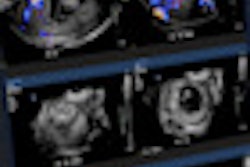
MINNEAPOLIS - Although the importation of outside imaging studies is often performed to reduce repeat imaging exams, transfer of historical images also yields a significant clinical benefit, according to research presented at this week's Society for Imaging Informatics in Medicine (SIIM) meeting.
From a one-year analysis, researchers from M. D. Anderson Cancer Center at the University of Texas in Houston found that only a very small percentage of imaging studies were less than one month old. And only 54% were four months old or less, according to Kevin McEnery, MD, who shared with SIIM attendees his institution's experience with importing images from outside films.
The M. D. Anderson team sought to gain a better understanding of the current state of outside image transfer and to determine the chronological ages of studies being transferred. This knowledge could assist in developing an archive maintenance plan, determine the proportion of film-based studies being imported, and forecast personnel staffing trends, McEnery said. It would also assist in developing policies for the management of outside studies.
Importing outside films offers a number of advantages, including enabling a single point of image retrieval for radiologists and clinicians. It also provides a single method of image viewing in an institution's native PACS, eliminating the inconsistency of vendor-provided image viewers, McEnery said.
"Most important for radiologists, prior images in a tertiary cancer center are crucial because you make a diagnosis of a patient's current disease status in the context of their prior imaging studies," he said.
As for disadvantages, manual importation of CDs requires changing the medical record number (MRN) from the outside institution to allow identification of the patient in the host system. It also increases the cost to maintain the host PACS. In addition, not all submitted disks are imported, due to proprietary compression of DICOM images or encryption, for example, McEnery said.
"It's our policy to reject any disks that do not have DICOM images," he said.
The researchers performed an importation analysis of outside media from September 1, 2008, to August 31, 2009, using data mining of PACS database files. During that period, 101,738 studies were imported. Of these, 76.8% were from digital media (CDs or DVDs), with the remainder imported from film digitization.
Fortunately, the percentage of film-based studies decreased during the study period. In September of 2008, 28% of the studies were film-based. That dropped to 18% in August 2009 and has continued to decline to 14% in April 2010.
The imported studies represented 21.7% of the total studies placed on the PACS during the year.
The ages of outside imaging studies transferred into PACS were as follows:
- Less than one month: 12.3%
- Four months old or less: 54%
- 40 months or less: 90%
Images submitted by film tended to be older studies compared to CD-based studies, McEnery said. Only 3.3% of film-based images were less than one month old, while 27% were less than three months old. Ninety percent were less than 76 months old.
In contrast, 15% of the digital images were less than one month old, 62% were less than three months old, and 90% were less than 19 months old.
The importation process at M. D. Anderson has enabled the successful transfer of more than 100,000 studies in the study period, and more than 375,000 since its inception, he said.
"The capability of image receipt from all over the country -- and, in some cases, the world -- is a testament to the success of the DICOM standard," McEnery said.
Despite this type of experience, image interoperability is not at the forefront of national interoperability standards, with meaningful use requirements not yet including imaging, McEnery said. Also, digital media transfer is an essential component of PACS operations, but physical media is arguably inefficient.
"It's clear that direct digital transfer will someday, I hope soon, supersede CD transfer," he said. "To this end, PACS vendors should be encouraged to adopt standard methods of direct PACS-to-PACS image transfer. This should be a standard part of any PACS system, and hopefully over the next several years this will be commonplace."
Historical studies
In terms of interoperability of radiology images, the focus has typically been on preventing duplicate imaging exams by facilitating image transfer between institutions. While that's valuable, the study findings suggest that the image transfer of historical studies also provides a clear benefit to the patient, McEnery said.
"The benefit of historical studies to the current management of the patient is equally if not more important [than avoiding repeat exams] for patient outcome," he said.
At M. D. Anderson, new patients are encouraged to bring their old imaging studies with them. This is done because access to the historical studies increases radiologists' diagnostic specificity, McEnery said.
The pattern of the age of images being transferred indicates both recent and historical images are being transferred. As a result, PACS archives are growing larger in size.
"The request of a patient to 'please provide a copy of all of my images' is going to be more and more onerous for us," he said. "Patients will be requesting not just current studies but also historical studies. So if you need to formulate your outside importation-exportation policies, you need to be aware that your patient is more than likely going to expect not just yesterday's study but last year's and the year before."
The idea that outside films could be placed in temporary image storage -- on the presumption that only recent images are being submitted -- may need to be rethought, McEnery said.
Local analysis will need to be performed to determine the best approach for each institution, he said. At M. D. Anderson, outside images are permanently archived.
McEnery acknowledged a number of limitations in the study, including its use of a tertiary cancer center patient population.
He concluded by stating that there is no technical reason why image transfer interoperability should be not be included in the U.S. government's meaningful use requirements for healthcare IT.
By Erik L. Ridley
AuntMinnie.com staff writer
June 4, 2010
Related Reading
RIS/PACS integration with personal EHR can be a tough task, April 5, 2010
CDs may come up short in long-term storage reliability, July 2, 2009
IHE's XDS-I profile may help with CD import dilemma, April 14, 2009
Testing procedure improves usability of DICOM CDs, January 22, 2007
Copyright © 2010 AuntMinnie.com


















